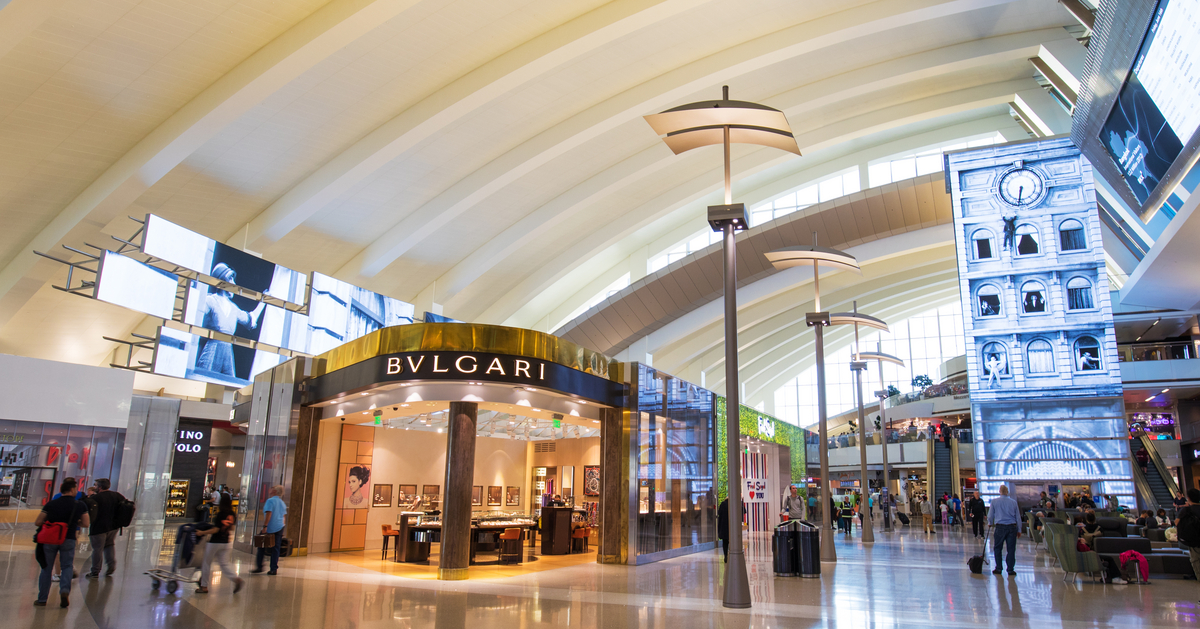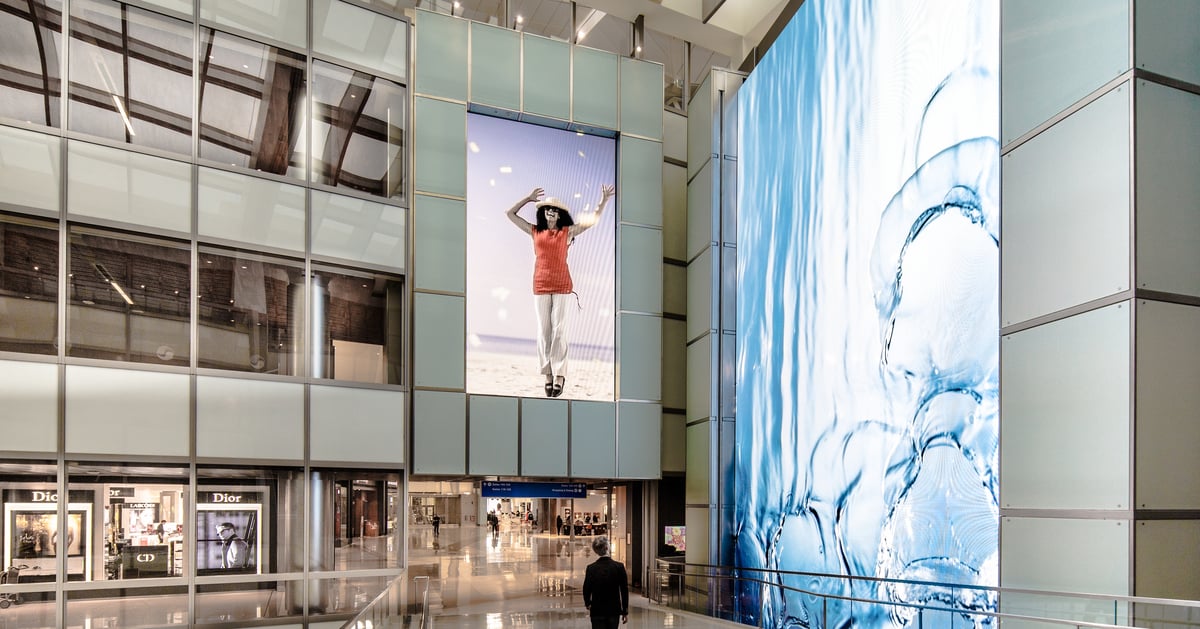
Transport Hubs - Increasing revenue with Experiential Technologies
As transportation operators invest in new or upgraded facilities to enhance passenger experience, they are also seeking new ways to increase revenue and achieve an improved return on their investment.
Growing retail partnerships represents an important revenue opportunity and many operators are recognizing that experiential technologies can help to attract more retailers.
Increasing non-travel revenue in transportation hubsTransportation operators derive their revenue from two main sources – travel-related and non-travel revenue. In the airport industry, for example, the global split of airport revenues is 54 percent aeronautical income and 40.2 percent non-aeronautical, with the remaining 5.7 percent from non-operating revenue, according to an article by Knaviation, 'How do Airports Make Money’.
Because aeronautical revenues have not yet fully recovered from the impact of the pandemic, they are not sufficient to cover operational and other costs, operators are aiming to diversify and grow non-aeronautical revenues with retail as a prime focus.
As a McKinsey & Company report ‘Turning on the Revenue Tap’ points out, millions of passengers at airports spend money on parking, food and drink and duty-free retail. However, when airports rent out store space to third-party shopping operators, they don’t have direct access to retail revenues, except through revenue-sharing agreements.
Retail revenue represents a major growth opportunity as figures from a case study on London Heathrow Airport’s financial results indicate:
- Retail revenues of $467 million in the nine months ending 30th September 2022 represented an increase of 238.5 percent over the same period in 2021.
- Income from retail concessions revenue of $183 million, up 240.5 percent from 2021, took the majority share of total retail.

Digital technologies reshaping airport retailing
Figures from a new benchmark study commissioned by Electrosonic, ‘The Revolution in Post-Pandemic Airport Amenities’, confirm the growing interest in retail opportunities. The report, based on interviews with development executives in more than 50 US airports, found that 82 percent of airport authorities interviewed were actively implementing or considering interactive retail partnerships with brands.
The development executives understand the potential of digital advertising to a large captive audience in the terminal as a means of creating a unique shopping experience and growing non-travel revenue.
However, a report from Bain & Company, ‘Airport Retail: Brace for Disruption’, highlights the importance for airport retailers in understanding the changing demographics of travelers. Airport retailers face a shift to younger, less affluent travelers so, to remain relevant, airport retail shops need to embrace digital retailing and adopt an omnichannel strategy.
The Bain report points out that an increase in the proportion of younger and less affluent travelers (has led to declining demand for traditional airport retail products and services, particularly the luxury goods that have previously attracted duty-free shoppers. To thrive in the coming decade, airport retailers need to change not only what they sell but how they sell.
The firm reports that, by 2025, the digital technologies that have reshaped the wider retail industry will radically transform traditional airport shopping, paving the way for omnichannel sales and seamless connection between digital platforms and in-store shopping.
The challenge for travel retailers is to embrace new digital ways of working that support greater flexibility and responsiveness as customer behavior changes. For example, retailers need to be nimble enough to add a new product or digital feature in a few test stores and evaluate within weeks what works and what doesn’t before introducing them in all stores.

Digital advertising enhances retail performance
Digital advertising will play a vital role in the transformation and profitability of transportation hub retailing. By implementing digital signage in high-traffic spaces, operators can maximize advertising revenues by reaching a diverse audience with dynamic and engaging content.
Airport digital signage solutions offer opportunities to display multiple ads, target specific demographics and make real-time content changes attracting advertisers seeking broad exposure and promoting mutually beneficial partnerships. As the Bain report points out, retailers need the flexibility to quickly and easily introduce and promote new products. Digital advertising is the perfect medium for that.
In an airport terminal, the main location for digital advertising is the retail and entertainment space. Departing passengers and other airport visitors are likely to spend the majority of their ‘waiting time’ in this space, so digital advertising systems will reach a large, captive audience. However, other areas, such as the departure hall or the arrival hall will also provide opportunities to reach travelers and visitors with relevant advertising messages while they wait.
By leveraging airport digital signage networks and attracting commercial partners, operators can generate significant ad revenues, ensure financial sustainability and create a thriving ecosystem of retail and commercial activity within the hub.
Experiential technology attracts more retailers
Experiential technology also plays its part in revenue generation by attracting more retailers to transportation hubs where the enhanced experience and engaging advertising can generate increased passenger spending.
Investing in experiential technology provides an enhanced passenger experience and raises the reputation of a transportation hub, which helps to attract retailers who are willing to spend more to be in a space that’s popular with travelers.
The Electrosonic benchmark study found that 82 percent of airport respondents are considering technology-enabled attractions that provide a turbo boost to airport branding, revenue and passenger satisfaction.
This is particularly important to high-value or premium brand retailers. At the Tom Bradley Terminal at Los Angeles International Airport, for example, the experiential technology raises the experience for travelers and, as a result, the terminal has attracted many premium brands and high-value retailers.
Electrosonic’s experience indicates that investment in experiential technology doesn’t just improve passenger satisfaction — it leads to important commercial and retail benefits that can increase non-travel revenue and boost profitability.
Better return on terminal investment
Improving passenger satisfaction through enhanced retail experiences is a key element of recent airport terminal upgrades.
However, while upgrades represent a major capital investment, deploying experiential technology and digital advertising can help contribute to increasing passenger satisfaction and loyalty, positively impacting passenger numbers and growing non-travel revenue, while helping help to improve overall ROI on the project upgrade.
Photography of Los Angeles International’s Tom Bradley International Terminal courtesy of Moment Factory.
Brandon Harp
Brandon Harp, Senior Business Development Manager at Electrosonic focuses on Airports, Transportation, Corporate and Retail verticals. He has a unique ability to look at technology through a creative lens with a consistent passion and determination to develop innovative and impactful solutions for clients. Brandon quickly identifies challenges and pain points by listening and communicating effectively. He is a knowledge expert, a problem solver, a thought leader, and a trusted advisor who always keeps the client’s best interests at heart. Brandon understands the importance of design, architecture, content, storytelling and experience and he is constantly looking for new and innovative ways of pushing the boundaries around what is possible.










.jpg?width=1500&height=995&name=ELC501_N17_medium%20(1).jpg)


![[Discover 50 Airport Executive Insights into passenger experience investment - Benchmark Report]](https://no-cache.hubspot.com/cta/default/5104351/7264d0bd-defe-49ca-9dca-d2f783d167bd.png)








































































































































































































